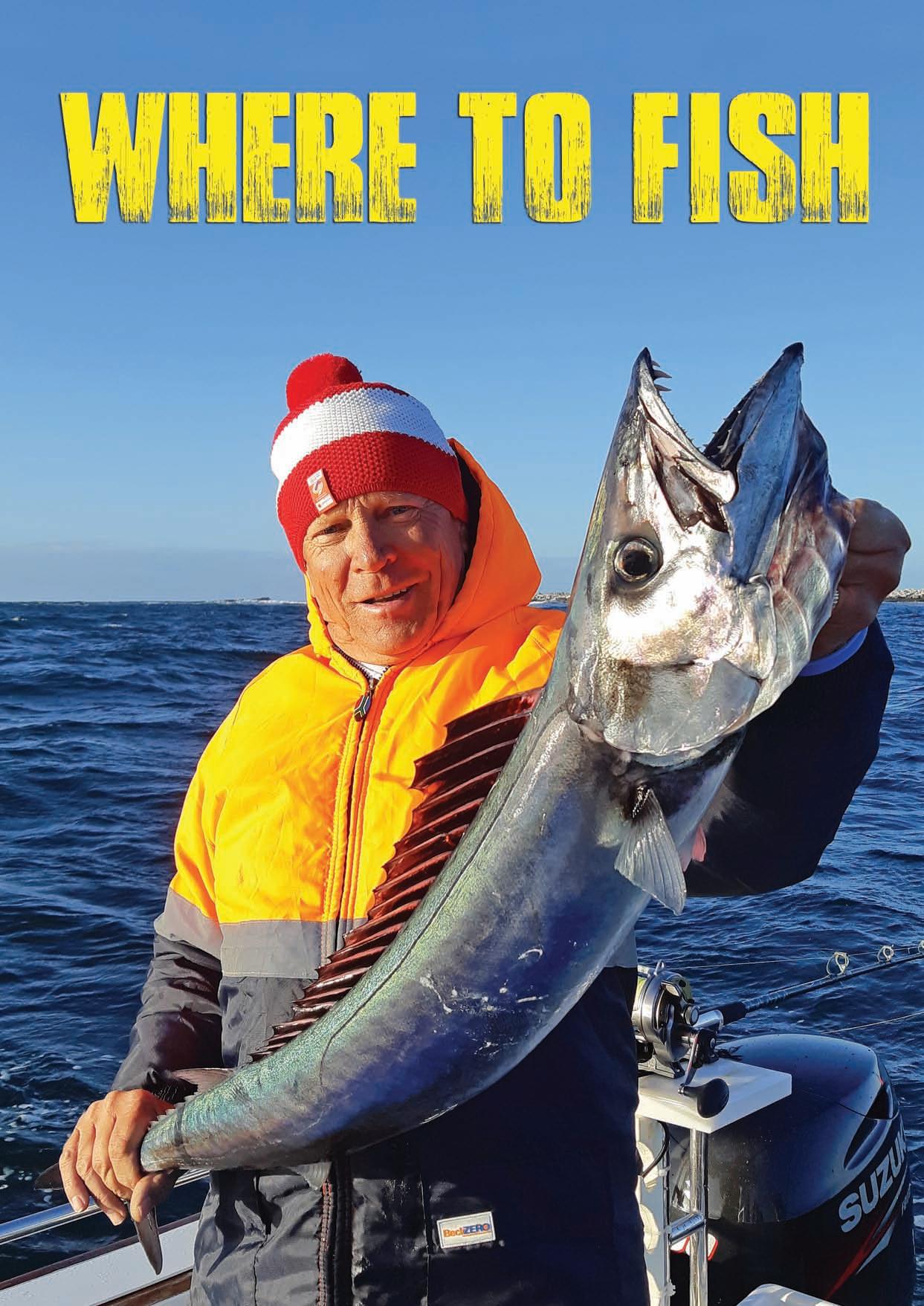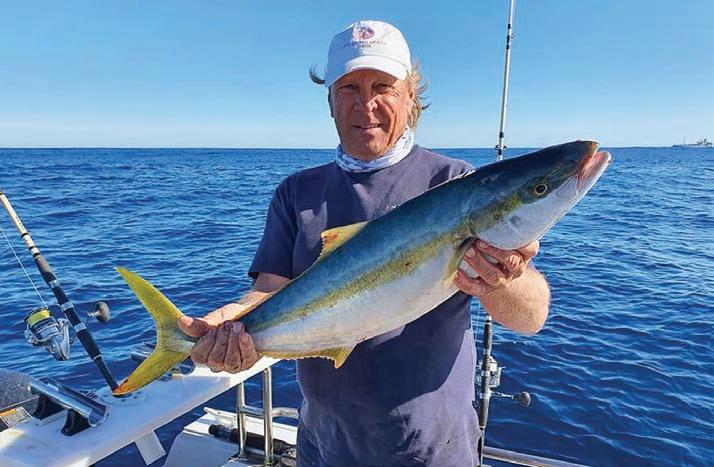
10 minute read
WHERE TO FISH
Part 7:Dassen Island and surrounds
By Vic Warrington
Advertisement
LET me start by introducing you to the boat fishing gateway to the west coast of South Africa, and probably the best kept secret in the country...
Going up the Cape west coast,the first town past Melkbosstrand is Yzerfontein which is about 95km north of Cape Town along the R27.This little village was always known to be the capital of the west coast.
Back in the day it was a holiday haven for most of the Swartland farmers and commercial fishermen.They built holiday homes and boat sheds to take a break from their farming lifestyle and chill on the coast.The fishermen arrived in numbers around the same time that the snoek and yellowtail arrived for their annual spawning.Of course there were also vast amounts of baitfish.The town is also famous for crayfish,which are caught from the pier wall and at Skaap Eiland on the west side of the town.
One of the country’s most spectacular fishing spots,Dassen Island,is situated about 10km west of Yzerfontein and 55km north of Cape Town.
Dassen Island is an uninhabited South African island in the Atlantic Ocean.The flat,low lying island measures about 3km long northwest-southeast and 1km wide,with an area of 2.73km 2 .It is a proclaimed nature reserve which is managed by Cape Nature Conservation and entry is strictly forbidden.
In Dutch das (the plural being dassen ) means badger.In Dutch/Afrikaans the word dassie means “rock hyrax”or “rock badger”and the island is named after the colonies of hyraxes encountered there by the discoverers.Named Ilha Branca (white island) by the early Portuguese mariners,it was renamed Elizabeth Eiland by Joris Van Spilbergen in 1601. The name Dasseneiland (Afrikaans) is preferred for official purposes.It was also occasionally referred to as Penguin Island because at one stage it was home to the largest African penguin colony in the world.
The island is underpinned by a finegrained tourmaline granite,with a few zones of biotite granite.The intrusive rocks are partly covered by sand,and along much of the shoreline large, rounded boulders protrude from the sand to heights just above the high water mark.Although temporary pans form during the wet season (winter) in the interior,there is generally little fresh water on the island.
Dassen Island is surrounded by reefs — except along its eastern side — and many ships have been shipwrecked here.

Vic Warrington with a beautiful yellowtail.

Happy charter client with an 87kg yellowfin tuna.


The yellowtail and snoek season normally starts at the beginning of July and lasts until the south easterly wind starts,then all the pelagic fish swim into the wind and eventually end up at Cape Point.
The snoek which used to be regular visitors,vanished from Dassen about 13 years ago but made a surprise comeback in 2021.What was strange about their presence at the north west side of the island was that there were no tell tale signs like diving malgas (Cape gannets) or frantic terns.The fish simply appeared deep down on the 25-03 of Boompunt.
I accidently found them while jigging for yellowtail at about 23m.After catching our quota,I notified the commercial boats,and in a matter of 24 hours there were more than 120 boats all chumming and working their dollies. It was an extremely festive time for the dorpie as the boats returned very heavy laden and the langanas (fish sellers) started bartering in their rather crude and foul language,but that is how it rolls on the west coast — rof en onbeskof when the snoek manne are in town.
The slipway at Yzerfontein is not a harbour as one might expect;it is a “day light slipway”,so called as it does not have port or starboard lights at its entrance.That slip is a nightmare for launching in any swell larger than 3 metres.It has a reputation for swallowing launching cars and trailer,so your man at the wheel of your vehicle really needs to know what he’s doing.A quick release system on the trailer is highly recommended.
The eastern side of Dassen Island — stretching from the “Dop”in the north east to the Kalkoond on the south east corner — is the most popular area for fishing.It’s common to find recreational fishermen there pulling back lines in search of resident yellowtail or snoek that decide to stay and not move with the rest of the shoal.These fish are normally massive over the summer period and do really put up a good fight.

A regular route used by the author heading from Yzerfontein to visit his favourite hot spots around Dassen Island.
Huisbaai (House Bay) is the most beautiful part of the island.It is situated on the northern side and is also a shelter for yachts and trawlers seeking a bit of rest or netting for crayfish.The bay is on the leeward side of the island and hence is very protected from the prevailing summer south easter.
The western side is where all the action takes place during winter.It features a famous granite rock with a huge square chunk that fell out,that is commonly known as Spuitklip (Pike Rock). The surge of upward spray can often be seen in Yzerfontein and from as far as the R27.It is commonly believed that if Pike Rock is working,it’s best to stay away from the island.
On the south side of the island are the Three Sisters,also known as The Roaring Sisters.These are three blinders that break periodically and without warning.If you’re in the wrong place at the wrong time it’s tickets for you,as those girls are vicious and a little skiboat has no chance.
Right out on the west side of the island about 3.5NM from the shore is a reef called South West Reef.It is always worth a visit if the westerly has been blowing for a few days because the fish are always attracted to the reef.Vertical jigging is always the best option on that reef if the fish are visible on the fishfinder,but are not surfacing.
If the snoek or yellowtail are there, then you can also expect to find some katonkel (Cape bonito) and slender tuna,normally under the bait balls.
Protea Reef is about 5.4NM SSW of Dassen and is very popular for quite a variety of fish including hotties which are now named Cape bream.This reef is much bigger than the South West Reef and has a southern extension that is also good for pelagic fish moving into the south easter en route to Cape Point and Robben Island.It is always a good idea to visit the two reefs if nothing is happening at the island.
You may wonder why the wind influences the movement of pelagic fish.Small baitfish,as we call them,are pelagic and they tend to swim into the wind to remain grouped.They migrate from way up the west coast,in fact from the Namibian coast.The westerly draws the small fish towards Lamberts Bay and then to St Helena Bay and on to Dassen Island,where they hang out for most of the time until the south easter arrives.
Another good snoek spot from years gone by is found north east of Dassen Island along the 16 Mile Beach,about 6 miles north of Yzerfontein in an area called bont duine (grey dunes).In the past when the snoek started appearing in the Yzerfontein area they always
started here.They would always appear right behind the breakers in a very sandy area.The sardines seem to lead them there for no apparent reason. That was about 15 years ago,but then they departed and have never returned.
Under normal conditions,most of the fishermen along the West Coast would scan the horizon for malgas and sterretjies diving with comorants on the surface,also getting in on the feeding frenzy,but lately these birds no longer behave in this manner and it’s all about electronic fishfinders now.
The fish have also changed their habits and have found a new delicacy, namely mantis shrimp,that is literally on the bottom of the ocean or between the kelp forests where they feed.It takes chumming and jigging to entice the fish up to the surface.The snoek boats use dollies and pike bait to lure them and then all the boats huddle close together to keep the shoal in the area.
The West Coast snoek are believed to be one of the heathiest eating fish in our waters because they have a very low mercury content and of course contain a large amount of omega 3 oils.
The other fish that is scientifically known to be the healthiest fish in our West Coast waters is the slender tuna. It has the highest count of omega 3 and almost no mercury in its flesh.It is not a nice fish to braai or eat raw,but is a brilliant fish to deep fry in a beer batter and serve with chips or on a bed of rice.
The most underrated eating fish along our coast is the katonkel (Cape bonito).These fish were commonly called kat kos (cat food) by commercial fishermen as there is simply no market for them.They are,however,very nice to eat raw,pickled or pan fried. Nowadays we are finding more and
more people asking for these feisty fighters instead of snoek or yellowtail.
The west coast is also well known for big game fishing at Dassen Gat which is about 36NM west of Yzerfontein.This hole is a massive crevice in the ocean bed where the depth suddenly drops to 1200m and then almost 2000 metres in “the ear” (an area shaped like an ear).
The Gat is well known for big eye and bluefin tuna which are normally quite large as you move further north towards the pinnacle off Saldahana Bay. I have personally pulled in a 91kg big eye in this region and recently a bluefin of 88.7kg.We normally launch at about 5.30am in the summer — as soon as the sun produces enough light that we can avoid running into the many whales that frequent the waters around the island.
In good conditions it takes about two hours to get to the Gat and scan the area using a reliable AIS (Automatic Identification System) to spot stern trawlers or long liners.If there are ships in the area we normally ask the skipper on channel 10 what time his nets will come up,and if it’s only a few minutes time,we hang around pulling a few deep divers,a flippy floppy or a spreader bar or two.If we do pick up good marks on the fishfinder (normally as the net bag becomes visible),then we up our back lines and start stripping and chumming the water.
Perfect conditions at Dassen Gat are when the water is clear and turquoise coloured,and the water temperature is between 18- and 22°C.Also look out for swooping tuna ducks — Cape gannetts and the massive albatross.More importantly,keep an eye on the surface for breaching longfin or yellowfin tuna. That behaviour is quite common when they are in a feeding frenzy,and you can be guaranteed a strike under those conditions.
When you’re out in the deep it’s extra important that you are well prepared.Be positive and make sure your drags are set correctly in advance,put on your Black Magic harness and have all your tools ready.Make sure this includes a long knife to cut a wedge in the tuna’s head to expose the spinal cord cavity.Also make sure your reamer is at hand to slide down the spine of the fish to settle it and improve the quality of the flesh.Once the tuna is prepared and bled,place the carcass in the fish box with plenty of ice.That will ensure that the warm-blooded fish is rapidly cooled down and will also maintains the good texture and quality of the much sought after loin flesh.
In an upcoming edition of SKI-BOAT I will look at the area north of Yzerfontein towards Saldanha Bay, Langebaan lagoon and up to Lamberts Bay.


